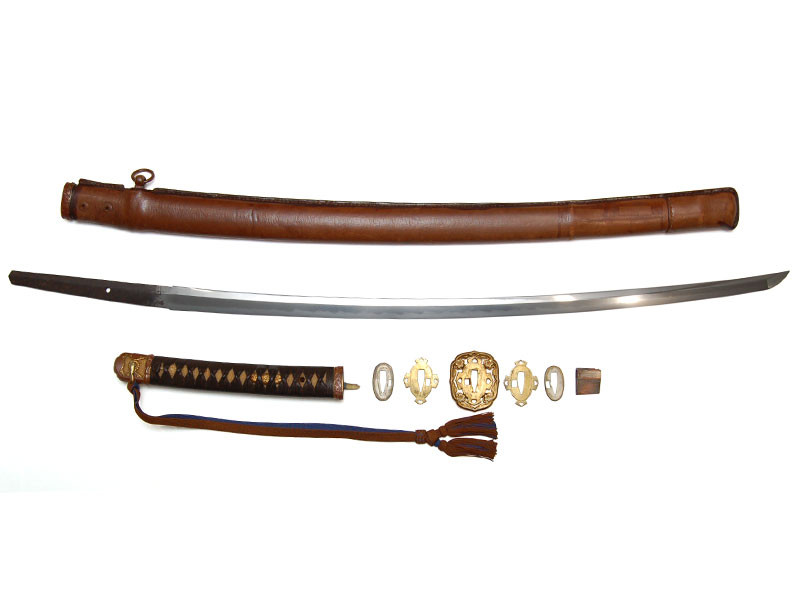




More informations about this product
| Total Weight | 1. 707 kg | |
| Weight without Saya | 1.053 kg | |
| Blade Weight | 0.697 kg | |
| Full length Naked Blade (Toshin) |
91.1 cm | |
| Nagasa | 71.6 cm | |
| Tsuka Length | 26 cm | |
| Sori (curvature) | 2.38 cm | |
| Kissaki Length | 3.10 cm | |
| Moto Haba | 2.8 cm | |
| Saki Haba | 1.79 cm | |
| Moto Kasane | A = 0.72 cm B = 0.77 cm |
|
| Saki Kasane | A = 0.47 cm B = 0.51 cm |
|
| Curvature | Tori Zori (Bizen Zori first third) | |
| Type Kissaki | Elongated Chū Kissaki | |
| Blade Structure | Shinogi zukuri (diamond shape) | |
| Mune | Iori mune (Triangular) | |
| Hamon | Floating Gunome Midare in Nie Deki | |
| Hada | Ko Itame Hada with Jinie, Ashi and Yo are present | |
| Boshi | Midare Komi with a rounded return (Kaeri) | |
| Nakago | Ubu (unaltered), Mumei (not signed). Length 19.50cm, 1 Mekugi Ana. Futsu Gata (classical shape), Yasurime Sujikai (diagonal file marks), Kurijiri Kengyo jiri (in V Shape) | |
| Saya | Type 98 gunto scabbard made of steel covered with leather, 77.8 cm length, weight 654g |
|
| Tsuka & Tosogu (Tsuba, Menuki, Fuchi Kashira) |
- Tsuka: 26cm length, 188g weight, Gunto Model 98 of high quality. Sarute in high quality. Unlocking push-button Chuso centered. Gilded Menuki with a 3 Sakura flowers design, braiding in patinated dark brown silk. Lieutenant style wriststrap in Brown & Blue. - Tsuba: 128g weight external dimensions: 7,02cm x 5,78cm x 0,5cm Gunto 98 type Tsuba with Sukashi (openings), very good quality. -Habaki: silver copper Habaki 2,68 x 2,99 x 1,05cm - Seppa: 2 seppa paris, total weight of 28g, 2 classical silver copper seppa (2x6g), and 2 quadrilobed gilded seppa (2x7g). |
|
| Study & Team Review |
Study:
This blade, not signed, is attributed to the Fujiwara Takada school.The smiths from the Takada school seldom signed their blades, if so they mainly their filiation "Fujiwara Takada" as the "Jumyo" movement. This is a very nice blade from the 17th century, the most productive of the Shinto sword period. This blade is a very fine making from Bungo, very much alike the Koto blades, it haves a very nice texture of Ko-Itame steel, with an elongated Kissaki with a particulary impressive curvature ! One can see many vairous influences, mainly the Yamato, Yamashiro and Bizen traditions ! NBTHK Hozon Certificate n°3017657 dated 30th of June 2018 (Heisei 30 - 6 Gatsu - 13 Nichi) The Fujiwara Takada school:
The forges of the Bungo (豊後) province in Kyushu (West Japan), not known since the Heian era (794 - 1185). The Takada Bungo school started during the Kamakura era (1185-1333) and grows particularly during the Muromachi era (1336-1573). The Bungo province is historically known for the excellency of the smiths of the Koto era, like Yukihira (行平) or Sadahide (定秀). This late one was also a priest in the Hikosan shirne in Fukuoka, Kyushu.The Takada school, also called Bungo Takada (豊後高田), was made official by Tomoyuki (友行) in the Takada during the Nanbokucho era division (1336-1392), at the beginning of Muromachi, of the warring states period. Tomoyuki is considered as a very high quality smith. The Bungo blades, even less reknown and underrated, were very researched for their sharpness and their strengthness, as often for the Kyushu blades. 3 great smiths, Muneyuki, Shigeyuki, and Yukinaga have even received the supreme title of "Yoki-Wazamono" for their remarkable sharpness and the cutting capacity of their blades. As for their signatures (Mei), the members of the Takada school during the Shinto era are alo called "Fujiwara Takada" (藤原高田), because they often used Fujiwara in their signatures. There are 3 big era of the Bungo smith, Ko-Takada before Muromachi, then Sue-Takada (Taira Takada) during Muromachi and, in the end, Fujiwara Takada starting the Azuchi Momoyama era (end of Koto, begining of Shinto). The Bungo Province:
The Bungo province is located in an island of Kyushu, in the west japan. It's in the neighborhood, of Hizen who have seen the famous smith lienage Hizen Tadayoshi, also beginning of Edo.This province and the one of Buzen were ruled by the Otomo during 400 years, from the Kamakura era to the Sengoku era. This clan was very important in the war effort to repel the Mongol invasions of 1274 and 1281. It was also one of the first clan to get into contact with the Europeans, and setting commercial relationships with them. Another remarkable fact, the arrival of the Jesuit Francis Xavier around 1549, meeting Otomo Sorin soon after, Shugo of the Bungo and Buzen provinces. Francis Xavier described him as a "King". Otomo Sorin converted to Catholiscism in 1578. It was the starting point of Catholicism in Japan. The military assembly Gunto 98 Type: The Tsuba and the Sarute of this assembly indicate a high quality. The finely worked Tsuba (with openings) shows it is a first edition from the beginning of the war. And the loop (Sarute) of the Kashira KAbuto Gane ot the handle is one of excellent quality. One can know the different kind of Gunto's Koshirae looking at the quality of the production and the fineness in the details. Indeed, the more World War II was ongoing, the more the assemblies were loosing quality due to the degradation of the materials used for the war effort. |
|
Share your opinion
error Your review appreciation cannot be sent
feedback Report comment
check_circle Report sent
error Your report cannot be sent